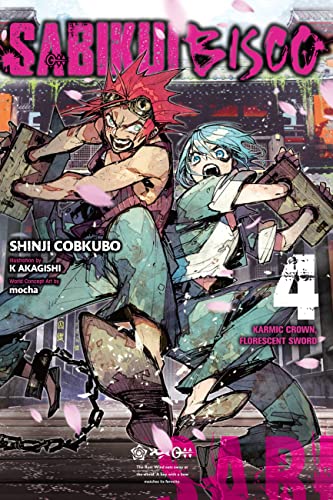By Shinji Cobkubo and K Akagishi. Released in Japan by Dengeki Bunko. Released in North America by Yen On. Translated by Jake Humphrey.
Sabikui Bisco tends to coast along on three elements. The first is what I would call “high concept”, coming up with fantastical ideas, people or places that make the jaw drop when they’re described. The second is the wall-to-wall action sequences that make up the bulk of the book. And the third is Bisco and Milo getting closer and closer to just making out, even as each book seems to add a new girl to fall in love with Bisco and sigh as she watches he and Milo declare themselves to be soulmates. The good news is that this fifth volume has all of those things in abundance. The bad news is that it does tend to lean a bit too much on the action scenes this time around. Bisco is not really someone who ever slows down or stops to smell the roses, but reading this book is like watching an action movie that’s all the last 15 minutes. It can be utterly exhausting.
After the events of the last book, Shishi is now apparently evil, and Bisco is very definitely a 10-year-old. As he and Milo try to catch up with her so that he can do something about that, they end up on Hokkaido… which it turns out is basically a giant floating space whale. That was not in any of the guidebooks! Unfortunately, Shishi got there first, and is trying to take over the island with camellia flowers… which have already taken over the prison wardens from the previous book. Fortunately, they have allies in the native peoples of Hokkaido, which include (yes, try to contain your surprise) another teenage girl who thinks Milo is pretty hot. She’s not into Bisco, though, as he’s just a kid. Will they be able to stop the island being used for a mass terrorist event? And just how evil *is* Shishi anyway?
The book makes an effort to try to keep it ambiguous about Shishi’s motivations, saying that it wasn’t just her being possessed by an evil flower but her own desires that led to her murdering her dad. But given that this motivational speech is coming FROM the evil flower, it’s a bit hard to take this as anything more than “sorry, bro, I was possessed”. Indeed, it’s not the only possession of the book, as the climax of the volume shows that there is no character the series will not bring back to make another appearance. Speaking of which, Pawoo is kept far away from her husband, but Tirol is around to be the absolute worst again, and Amli also shows up to try to save her god/crush delete where applicable. This is a series that thrives on barely controlled chaos, so it works, but eventually the “controlled” part is going to be lost, I suspect.
Still, overall I was less grumpy about this book, despite it basically just being Bisco and Milo screaming for 260 pages. I’ll keep going.


